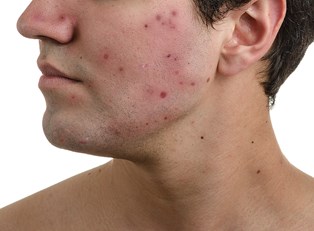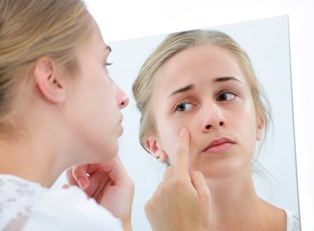Cystic acne is a painful condition marked by large, painful cysts that develop under the skin. While it shares some similarities with other forms of acne, it is generally considered the most severe out of all of them. Unlike typical acne breakouts, cystic acne can last well into adulthood, and even with treatment it may linger for years.
Below is a look at the basics of this potentially debilitating disease—including its causes, risk factors, symptoms, and treatments.
Causes of Cystic Acne
While cystic acne is much more severe than other varieties of the condition, its causes are roughly the same as the others. However, it should be noted that there is still much that is unknown about the precise mechanics of acne.
Most researchers believe that cystic acne begins internally as a hormonal imbalance—specifically, the presence of too much androgen in the body. Although the process is still unclear, when this hormone is present in excessive quantities, it sends erroneous signals to the skin’s sebaceous glands, which are responsible for producing skin oil that is also known as sebum. These signals cause the glands to produce too much sebum, which then becomes clogged in a person’s pores.
As the pores continue to produce oil, they begin to swell and become inflamed. Under enough pressure, they will eventually burst, which leads to the actual production of cysts under the skin.
Risk Factors of Cystic Acne
Teenagers and young adults are at the highest risk of developing cystic acne, since hormones are typically the most tumultuous during this stage of life. However, women who are pregnant or are currently going through menopause may also be at risk due to the hormonal changes associated with these life events. There is some research indicating that cystic acne has a genetic basis, so those with a family history of the condition may be considered as having a higher risk for it as well.
Ultimately though, there is still so much unknown about cystic acne that it can be difficult to accurately predict who will develop it.
Symptoms of Cystic Acne
People with cystic acne may experience typical acne problems, such as whiteheads and blackheads. However, their symptoms are typically more severe and extend beyond this.
As it was mentioned earlier, cysts form under the skin when the pores burst because of the pressure buildup caused by excess sebum. These cysts are quite painful and may feel like solid, hard bumps. Additionally, cysts may give the skin a red, raised appearance. Cystic acne is also typically more widespread than other varieties and can extend across the face, neck, back, and chest of a patient.
Treatment of Cystic Acne
Unfortunately, the most popular over-the-counter products used to treat other forms of the condition will have little to no effect on cystic acne. Instead, prescription strength treatments are necessary for dealing with it.
For women,hormonal birth control is frequently recommended as a first attempt at treating cystic acne. It can help manage the underlying hormonal causes of the condition, and its side effects are relatively mild compared to those of other acne-fighting products.
Additionally, isotretinoin (which is sometimes referred to as Acutane) is another oral medication that’s frequently used in the treatment of cystic acne. It helps reduce the amount of sebum produced by the sebaceous glands and is considered the most effective product for treating this condition. However, it comes with some potentially serious side effects—including liver damage, hair loss, headaches, and fetal abnormalities in pregnant women.
In extreme cases, cysts can be surgically extracted and drained, but this can only be done by a medical professional. While this procedure can help alleviate the pain associated with sebum buildup, the process itself may still be painful.



